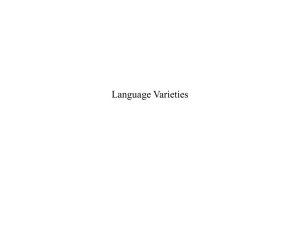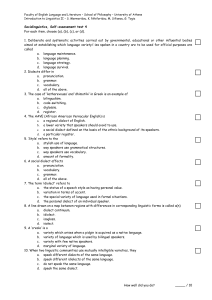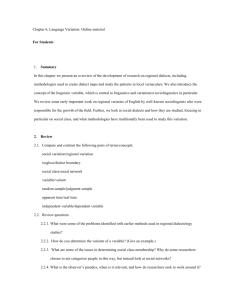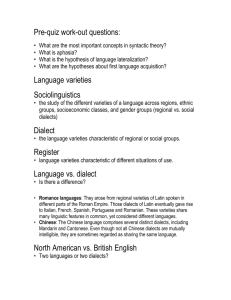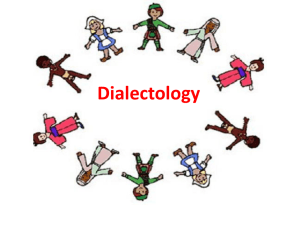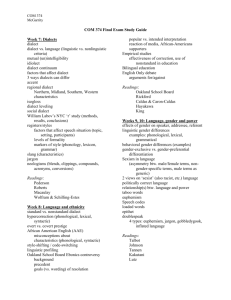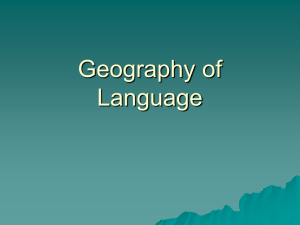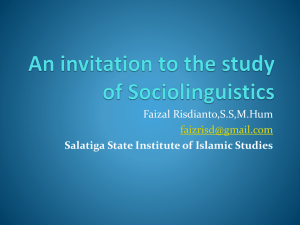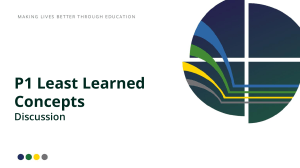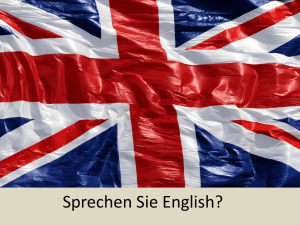Language Variation: Dialects, Sociolects, and More
advertisement
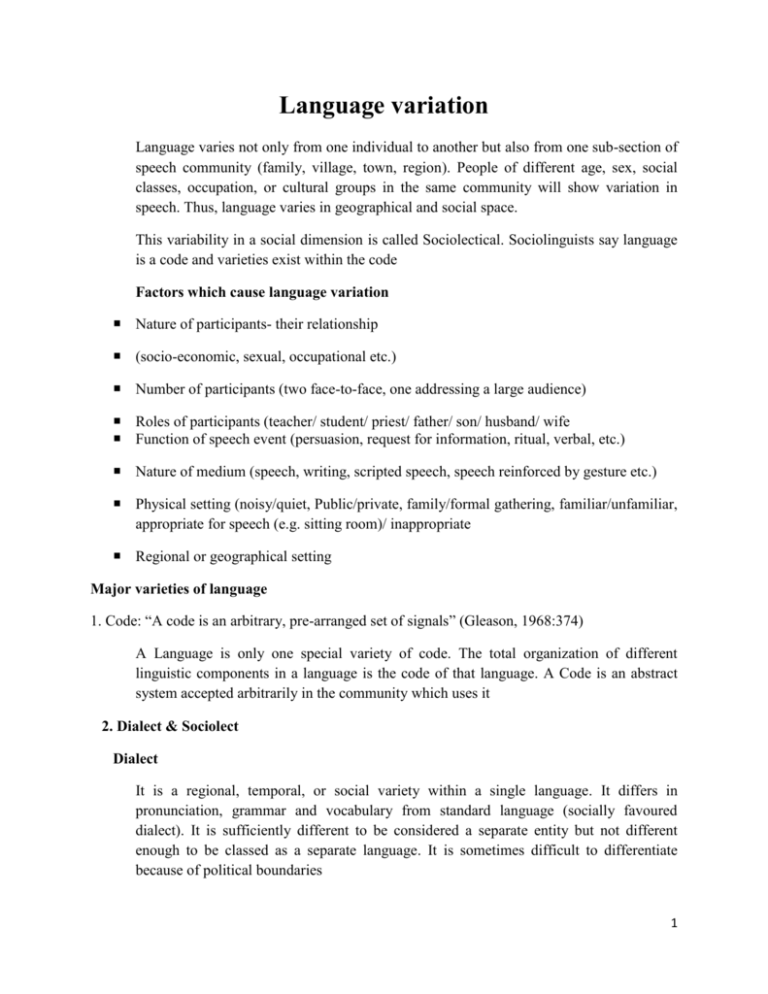
Language variation Language varies not only from one individual to another but also from one sub-section of speech community (family, village, town, region). People of different age, sex, social classes, occupation, or cultural groups in the same community will show variation in speech. Thus, language varies in geographical and social space. This variability in a social dimension is called Sociolectical. Sociolinguists say language is a code and varieties exist within the code Factors which cause language variation Nature of participants- their relationship (socio-economic, sexual, occupational etc.) Number of participants (two face-to-face, one addressing a large audience) Roles of participants (teacher/ student/ priest/ father/ son/ husband/ wife Function of speech event (persuasion, request for information, ritual, verbal, etc.) Nature of medium (speech, writing, scripted speech, speech reinforced by gesture etc.) Physical setting (noisy/quiet, Public/private, family/formal gathering, familiar/unfamiliar, appropriate for speech (e.g. sitting room)/ inappropriate Regional or geographical setting Major varieties of language 1. Code: “A code is an arbitrary, pre-arranged set of signals” (Gleason, 1968:374) A Language is only one special variety of code. The total organization of different linguistic components in a language is the code of that language. A Code is an abstract system accepted arbitrarily in the community which uses it 2. Dialect & Sociolect Dialect It is a regional, temporal, or social variety within a single language. It differs in pronunciation, grammar and vocabulary from standard language (socially favoured dialect). It is sufficiently different to be considered a separate entity but not different enough to be classed as a separate language. It is sometimes difficult to differentiate because of political boundaries 1 Another definition of Dialect: Dialect is a specific form of a given language, spoken in a certain locality or geographical area showing sufficient differences from the standard of literary form of that language, as to pronunciation, grammatical construction and idiomatic use of words, to be considered a distinct entity, yet not sufficient distinct from other dialects of the language to be regarded as a different language – A dictionary of Linguistics (1945) A. Pie and Frank Gaynor Sociolects (Social dialects or class dialects) Sociolect is spoken by the members of a particular group or stratum of a speech community 3. Isogloss An isogloss is a line indicating the degree of linguistic change. (Gleason 1963 : 398) Isogloss is a representation of statistical probabilities, a graphic way of portraying a translation of speech characteristics of one area to another, a bundle of isoglosses may be interpreted as marking a zone of great translation of speech. It indicates a dialect boundary. It is a term modelled on geographical terms – Isotherm( a line joining areas of equal temperature) and Isobar (a line joining areas of equal atmospheric pressure. It is in contrast to Isograph- any line on a linguistic map, indicating a uniformity in the use of sounds, vocabulary, syntax, inflection, etc. 4. Register Registers are varieties of language according to use. They are stylistic functional varieties of a dialect or language. They are narrowly defined by reference to subject matter (field of discourse – jargon of fishing, sports etc.) to medium (mode of discourse e.g. printed material, written, letter, message on tape etc.) or level of formality i.e. style (manner of discourse) Some definitions of Registers By register we mean a variety correlated with performer’s social role on a given occasion. Every normal adult plays a series of different social roles- one man ,for example, may function at different times as head of a family, motorist, cricketer, member of a religious group, professor and so on, and within his idiolect he has varieties shared by other persons and other idiolects appropriate to these roles. 5. Idiolect 2 It is a variety of language used by one individual speaker, including peculiarities of pronunciation, grammar, vocabulary etc. A dialect is made of idiolects of a group of speakers in a social or regional subdivision of a speech community. 6. Diglossia When two or more dialects or languages in regular use, the situation called diglossia One dialect or language given higher status or prestige, and is reserved for certain functions in a society, such as government, education, the law, religion, literature, press, radio and TV. The prestige dialect is often called the standard dialect (the language). 7. Pidgin A pidgin is a contract language, a mixture of elements from different natural languages.Its use is restricted to certain groups, e.g. traders & seamers. It is used in some parts of Asia. An example is Chinese pidgin which is used for limited purpose of trade. It is also called contact vernacular. 8. Creole When pidgin becomes linguafranca, it is called Creole. It extends beyond limited function and enters other activities. Then it has standardized grammar, vocabulary and & sound system. It is spoken by increasing number of people as first language. So, a creole is a mixed natural language composed of elements of different languages in areas of intensive contact. Examples: creoles of islands of Mauritius and Haiti. 3
